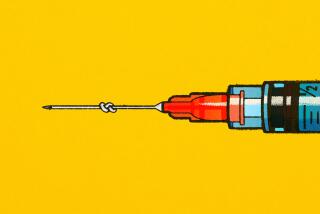Types of dermal fillers
- Share via
Determining the best filler for your facial needs is challenging, with more than a dozen brand-name options available to consumers. Some fillers are more effective on different areas of the face, and the number of treatments needed depends on the state of the skin. Superficial lines will respond well to one treatment, while deeper wrinkles may require multiple visits. Here is a quick look at six different types:
Blood-based
What is it: This filler, which goes by the brand name Sephyl, uses the patient’s own blood as a filler by centrifuging the blood to collect fibrin (a protein that helps blood clot) and platelets, which are subsequently injected back into the body to stimulate collagen growth. The filler was approved by the Food and Drug Administration in October 2009 for use on frown lines between the brows, laugh lines, acne and post-op scars and costs $1,100 per treatment.
Pros: Results are supposed to last at least 18 months, and since the patient’s own blood is used there is no risk of allergic reaction.
Cons: Although early studies are optimistic, some dermatologists, including Dr. Neal Schultz of DermTV.com, are waiting for larger-scaled studies to determine the effectiveness. “In harvesting and concentrating the components of the product, there are many opportunities for contamination,” Schultz says.
Calcium-based
Radiesse, composed of calcium hydroxylapatite microspheres, adds volume to wrinkles and folds, and also stimulates collagen production to help restore fullness to the face. The treatment costs from $600 to $1,500 per treatment.
Pros: “Radiesse lasts longer than Juvéderm [see below] and is great for the deeper folds around the mouth,” says New York plastic surgeon Dr. Nina Naidu.
Cons: Unlike stem cell fillers, the results are not permanent, lasting up to 12 months. Since the syringe that’s needed for the injections is larger than other fillers, Radiesse is less effective for use on finer lines.
Hyaluronic acid
Hayaluronic acid, made of complex sugars natural to the body, retains water like a sponge, absorbing more than 1,000 times its weight and plumping skin in the process. Numerous companies offer this kind of filler, including Prevelle, Restylane and Perlane. New combinations with lidocaine, including Juvéderm XC and Hydrelle, reduce pain during injection. Each treatment costs about $600 to $800; the first one usually lasts four to six months, while subsequent treatments can last as long as a year.
Pros: “Hyaluronic fillers are the best option for natural-looking, long-acting dermal fillers,” says Dr. Debra Luftman. Plus, if you’re unhappy with results, the filler can be immediately broken down with an enzyme known as hyaluronidase.
Cons: In some areas, such as the lips, where blood flow is greater, results may last only two to four months, making this an expensive investment.
Permanent
What it is: The two most common permanent fillers are Artefill and silicon. A microdroplet technique is used to inject silicon into the skin. The procedure is not approved by the FDA for aesthetic use and is controversial. Artefill, on the other hand, is composed of collagen and poly (methyl) methacrylate, or PMMA, microspheres. The collagen is partially reabsorbed into the body while the microspheres are left behind. Artefill is FDA-approved for use on the nasolabial folds, also known as laugh lines, and costs $500 to $700 per injection.
Pros: Results are permanent and not subject to the aging process. Plus, the option is less expensive than lifelong injections every four to 12 months.
Cons: Since the material is not native to the body, there is risk of allergy, infection and chronic inflammation. Also, silicone can cause granulomas or bumpy scars.
Poly-L-lactic acid
What is it: Sculptra was initially approved in 2004 for patients with facial wasting as a result of HIV. The synthetic filler was approved for aesthetic use in 2009. The same compound as in resorbable stitches, poly-L-lactic acid is biocompatible and biodegradable, and it helps replace lost collagen in the treatment area. The price ranges from $300 to $500 per cc, and it usually requires one to two cc’s per treatment.
Pros: One of the few dermal fillers that effectively restores youthful volume to the face and lasts almost 24 months. Plus, “the improvement is slow and gradual so it looks very natural,” Schultz says.
Cons: Sculptra is devised as a treatment series of up to four injections, scheduled three weeks apart over a three-month period. “Sculptra isn’t appropriate for filling in individual wrinkles or plumping lips,” adds Dr. Jessica Wu.
Stem cell
What is it: Extracted stem cells from fatty tissue are injected into the face and produce new blood vessels, collagen and nutrients using a chemical language to communicate with their surroundings. “This process restores youthful volume and lifts sagging skin,” says board-certified dermatologist Dr. Nathan Newman.
Pros: Stem cells fully integrate into the face, making the transformation look natural, and results are permanent (although subject to the natural process of aging).
Cons: The hefty price tag (ranging from $5,500 for treating one area of the face to $9,500 for the whole face) may be cost-prohibitive. Plus, many experts believe additional trials are necessary before establishing safety and efficacy.






